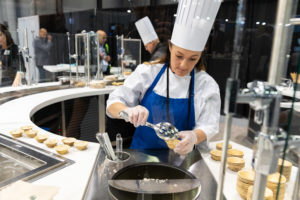written by Stephanie Herrett
TORONTO – Supply chain. These two simple words are part of our vocabulary now more than ever. We’ve all had trouble finding certain products and cringe when we see “out of stock” or “backordered” on our favorite shopping website. Just as the supply chain dilemma has affected our daily lives, these difficulties have made their way into the foodservice design and equipment manufacturing community. The question we face is how do global supply chain issues impact commercial kitchen design?
 We will focus on identifying some of the key obstacles our designers encounter and provide solutions to create a functional facility that minimizes the hardship associated with current supply chain issues while providing the flexibility to navigate the future.
We will focus on identifying some of the key obstacles our designers encounter and provide solutions to create a functional facility that minimizes the hardship associated with current supply chain issues while providing the flexibility to navigate the future.
Long Lead Times for Equipment
Equipment manufacturers are dealing with unprecedented disruption and stoppages in production caused by unavailable raw manufacturing components and labour shortages. Add into the equation shipping, rail, and trucking delays and it’s no surprise that there are long lead times for equipment. In fact, some are as long as 20 weeks from the time of order.
What can we do to minimize the disruption these delays can cause in the project without sacrificing its integrity? How can we combat the long lead times?
Think Offense Not Defense
Planning ahead and being prepared with creative and flexible design options relieves the stress of having to re-allocate, re-design, and re-specify because of supply chain disruptions. When we think offensively and have a Plan B and even C in our pocket from the beginning, costly and unfortunate project overruns are eliminated or at least minimized. The result is an innovative foodservice facility with design elements that accommodate global missteps along with current and future trends, viable long after the supply chain problem goes away, not a facility of compromised design caused by temporary supply issues.
Specify Equipment Early
Once the needs of the facility are understood and programming is underway, it’s not too early to think about equipment specification. How can multi-functional equipment be incorporated? Which equipment sources have inventory in stock or with shorter lead times? Can “alternates” be quoted that are readily available? It’s key to have an open line of communication with the equipment manufacturers as well as bidders to ensure accurate information is at your fingertips.
Phase the Project
Another option is to phase the project so that some areas can be operational while you wait for backordered equipment to arrive and be installed in other areas. While not ideal, it allows for a “soft” opening to promote the establishment until the grand opening.
 Food Costs and Supply Concerns
Food Costs and Supply Concerns
Difficulties with sourcing certain foods means that chefs and operators have become even more creative with doing more with less. Streamlining menus to offer flexibility in food offerings minimizes supply hardships. For example, instead of compromising on the taste or quality of the dish by using lesser cuts of meat, recreate your menu with new and different offerings utilizing cuts of meat that are more readily available and cost-effective.
We can all agree that food costs are on the rise. Inflation mixed with the supply chain conundrum has resulted in rising food costs on the operator’s side and increased menu prices for the customer. Researching and sourcing food that is locally grown eliminates unnecessary shipping costs. Purchasing in bulk well ahead of time or when items are available at a lower cost is a great solution to offset this problem but only if there is adequate space to store the food while preventing unnecessary spoilage with appropriate cold storage provisions.
Multi-functional equipment reduces the footprint of the cookline, allowing for more space to be allocated for other needs in the kitchen such as dry and cold storage, for example. Equipment like blast chillers and vacuum packaging (vac pac) machines are essential components to extend the shelf life of the food product without deteriorating or spoiling its quality.
Planning a roof or outdoor garden area, or even an indoor herb garden, will ease some of the food supply concerns while offering the extra benefit of creating a sustainable environment.
It’s Only Temporary
The supply chain hurdles of today, while costly in time and money to everyone involved, can be overcome with forethought and plain old-fashioned creativity on the part of the entire design team. By continually seeking innovative strategies to offset supply issues, the industry will weather this and future disruptions.
Stephanie Herrett is project manager at Cini-Little International, Inc., Toronto. This article appears courtesy of Cini-Little International.
